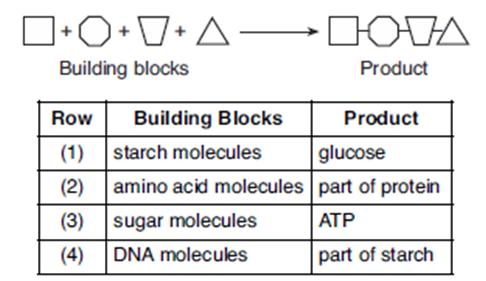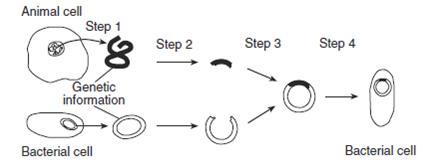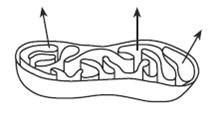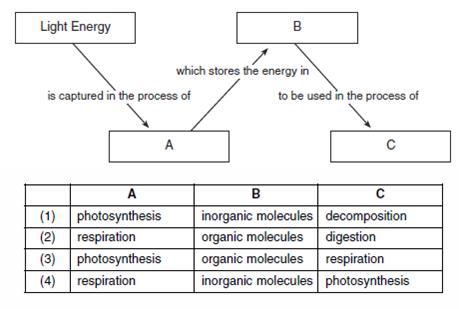| 1. | The energy in the food produced by plants or taken into the bodies of animals must be changed into a form that cells can use. The energy-transferring molecule used by cells is — | |
| A. | DNA | |
| B. | RNA | |
| C. | ATP | |
| D. | ADP | |
| 2. | Compared to a skin cell, a muscle cell is likely to have more — | |
| A. | chloroplasts | |
| B. | cell membranes | |
| C. | mitochondria | |
| D. | nuclei | |
| 3. | In plant cells, the organelles that conduct photosynthesis and the organelles that conduct cellular respiration are the — | |
| A. | chloroplasts and chromoplasts | |
| B. | chloroplasts and ribosomes | |
| C. | mitochondria and ribosomes | |
| D. | chloroplasts and mitochondria | |
| 4. | The diagram below represents a process that occurs in a structure of a specialized cell. Which row in the chart correctly identifies the letters in the diagram?
|
||
| A. | 1 | ||
| B. | 2 | ||
| C. | 3 | ||
| D. | 4 | ||
| 5. | The diagram below represents the synthesis of a portion of a complex molecule in an organism. Which row in the chart could be used to identify the building blocks and product in the diagram?
|
||
| A. | 1 | ||
| B. | 2 | ||
| C. | 3 | ||
| D. | 4 | ||
| 6. | In what way are photosynthesis and cellular respiration similar? | |
| A. | They both occur in chloroplasts. | |
| B. | They both require sunlight. | |
| C. | They are both controlled by enzymes | |
| D. | They both require oxygen and produce carbon dioxide | |
| 7. | Which substance is the most direct source of the energy that an animal cell uses for the synthesis of materials? | |
| A. | ATP | |
| B. | DNA | |
| C. | glucose | |
| D. | starch | |
| 8. | Examine the diagram below, which illustrates some steps in genetic engineering. What is the result of step 3?
|
||
| A. | a new type of molecular base is formed | ||
| B. | different types of minerals are joined together | ||
| C. | DNA from the bacterial cell is cloned | ||
| D. | DNA from different organisms is joined together | ||
| 9. | Which statement concerning proteins is not correct? | |
| A. | Proteins are long, usually folded, chains. | |
| B. | The shape of a protein molecule determines its function. | |
| C. | Proteins change shape when sujected to high temperatures | |
| D. | Proteins are bonded together, resulting in simple sugars. | |
| 10. | The diagram below represents a cell organelle involved in the transfer of energy from organic compounds. The arrows in the diagram could represent the release of
|
||
| A. | ATP from a chloroplast carrying out photosynthesis | ||
| B. | oxygen from a mitochondrion carrying out photosynthesis | ||
| C. | glucose from a chloroplast carrying out photosynthesis | ||
| D. | carbon dioxide from a mitochondrion carrying out respiration | ||
| 11. | Which set of terms best identifies the letters in the diagram below?
|
||
| A. | 1 | ||
| B. | 2 | ||
| C. | 3 | ||
| D. | 4 | ||
| 12. | The arrows in the diagram represent biological processes. Identify processes 1 and 3.
|
||
| A. | Process 1 is respiration, process 3 is digestion | ||
| B. | Process 1 is digestion, process 3 is respiration | ||
| C. | Process 1 is respiration, process 3 is photosynthesis | ||
| D. | Process 1 is photosynthesis, process 3 is respiration | ||
| 13. | A characteristic of a DNA molecule that is not characteristic of a protein molecule is that the DNA molecule | |
| A. | can replicate itself | |
| B. | can be very large | |
| C. | is found in nuclei | |
| D. | is composed of subunits | |
| 14. | ATP is produced during which of the following processes? | |
| A. | Photosynthesis | |
| B. | Aerobic Respiration | |
| C. | Fermentation | |
| D. | All of the above | |







